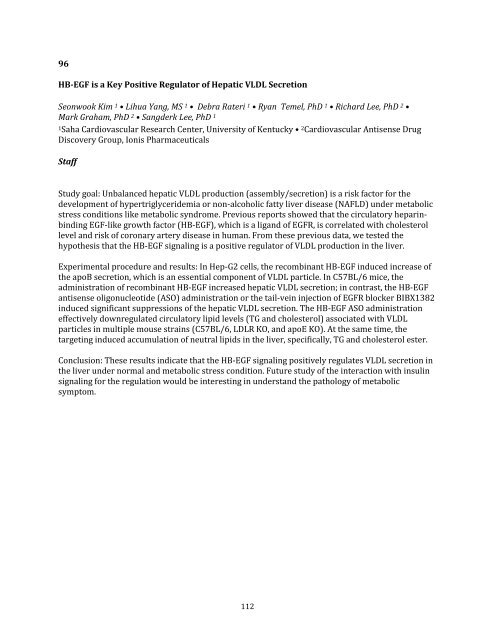2017 Cardiovascular Research Day Abstract Book
You also want an ePaper? Increase the reach of your titles
YUMPU automatically turns print PDFs into web optimized ePapers that Google loves.
96<br />
HB-EGF is a Key Positive Regulator of Hepatic VLDL Secretion<br />
Seonwook Kim 1 • Lihua Yang, MS 1 • Debra Rateri 1 • Ryan Temel, PhD 1 • Richard Lee, PhD 2 •<br />
Mark Graham, PhD 2 • Sangderk Lee, PhD 1<br />
1Saha <strong>Cardiovascular</strong> <strong>Research</strong> Center, University of Kentucky • 2 <strong>Cardiovascular</strong> Antisense Drug<br />
Discovery Group, Ionis Pharmaceuticals<br />
Staff<br />
Study goal: Unbalanced hepatic VLDL production (assembly/secretion) is a risk factor for the<br />
development of hypertriglyceridemia or non-alcoholic fatty liver disease (NAFLD) under metabolic<br />
stress conditions like metabolic syndrome. Previous reports showed that the circulatory heparinbinding<br />
EGF-like growth factor (HB-EGF), which is a ligand of EGFR, is correlated with cholesterol<br />
level and risk of coronary artery disease in human. From these previous data, we tested the<br />
hypothesis that the HB-EGF signaling is a positive regulator of VLDL production in the liver.<br />
Experimental procedure and results: In Hep-G2 cells, the recombinant HB-EGF induced increase of<br />
the apoB secretion, which is an essential component of VLDL particle. In C57BL/6 mice, the<br />
administration of recombinant HB-EGF increased hepatic VLDL secretion; in contrast, the HB-EGF<br />
antisense oligonucleotide (ASO) administration or the tail-vein injection of EGFR blocker BIBX1382<br />
induced significant suppressions of the hepatic VLDL secretion. The HB-EGF ASO administration<br />
effectively downregulated circulatory lipid levels (TG and cholesterol) associated with VLDL<br />
particles in multiple mouse strains (C57BL/6, LDLR KO, and apoE KO). At the same time, the<br />
targeting induced accumulation of neutral lipids in the liver, specifically, TG and cholesterol ester.<br />
Conclusion: These results indicate that the HB-EGF signaling positively regulates VLDL secretion in<br />
the liver under normal and metabolic stress condition. Future study of the interaction with insulin<br />
signaling for the regulation would be interesting in understand the pathology of metabolic<br />
symptom.<br />
112


